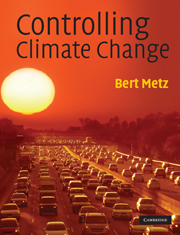Book contents
- Frontmatter
- Contents
- Preface
- 1 Climate change and its impacts: a short summary
- 2 Greenhouse gas emissions
- 3 Keeping climate change within sustainable limits: where to draw the line?
- 4 Development first
- 5 Energy Supply
- 6 Transportation
- 7 Buildings
- 8 Industry and waste management
- 9 Land use, agriculture, and forestry
- 10 How does it fit together?
- 11 Policies and measures
- 12 International climate change agreements
- Index
- Plate section
9 - Land use, agriculture, and forestry
Published online by Cambridge University Press: 05 June 2012
- Frontmatter
- Contents
- Preface
- 1 Climate change and its impacts: a short summary
- 2 Greenhouse gas emissions
- 3 Keeping climate change within sustainable limits: where to draw the line?
- 4 Development first
- 5 Energy Supply
- 6 Transportation
- 7 Buildings
- 8 Industry and waste management
- 9 Land use, agriculture, and forestry
- 10 How does it fit together?
- 11 Policies and measures
- 12 International climate change agreements
- Index
- Plate section
Summary
What is covered in this chapter?
Agriculture and forestry together are responsible for about 30% of greenhouse gas emissions, partly from loss of carbon from soils and vegetation and partly from agricultural activities producing methane and nitrous oxides. Demand for food is the dominant driver of developments in agriculture and deforestation. Food security has always been high on the political agenda as is visible in the strong reactions to recent increases in food prices. There is a large potential to reduce emissions. Increasing carbon in agricultural soils, livestock manure management and conserving carbon in forests by reducing deforestation, planting new forests, and better forest management can halve emissions by 2030 at reasonable costs. Policy actions to realize this potential can best be focused on reforming the many existing policies and create financial incentives for farmers and forest owners to change their practices. International climate policy instruments created by the Kyoto Protocol can contribute.
Land use trends
About one-third of global land is used for agriculture. Two-thirds of that land is grassland, one-third cropland. Forests cover about 25%. The rest (about 40%) is desert, tundra, ice, wetland, or other natural area, except for a small amount covered by urban areas (less than 0.5%). Over time shifts have occurred from forested land to agricultural land (cropland and grassland), consistent with the increase in the world population and the need for food. Over the last 40 years agricultural land has increased by about 500 Million hectare (Mha) or 10%.
- Type
- Chapter
- Information
- Controlling Climate Change , pp. 235 - 260Publisher: Cambridge University PressPrint publication year: 2009



